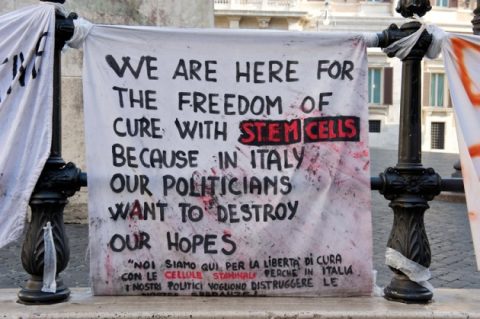
Using stem cells to treat disease or improve recovery is an exciting area of research. The potential is undeniably great – these are cells that have the potential to differentiate into mature cells of a specific type. They can be used to replace damaged cells or improve the environment for cell function and recovery. Ideally stem cells can be developed from cells harvested from the patient themselves, so there is no issue of rejection.
Stem cell technology, however, is tricky and currently in its infancy. One challenging hurdle is to prevent transplanted stem cells from turning into tumors. We also need the cells to do what we want and to survive long enough to be useful. Research is progressing, but the potential for stem cells has not yet been realized.
Quackery in the gap
Into this gap between the hype and potential of stem cells and the current reality of the research there is a space where dubious stem cell clinics can thrive. I first wrote about dubious stem cell clinics debuting in China nine years ago. Despite various regulatory efforts these clinics continue to thrive.
At first such clinics popped up in countries with relatively poor regulation of medical treatments, leading to an industry referred to as stem cell tourism. However, dubious stem cell clinics have started popping up in the US as well.
Just type “Stem Cells” and “US” into Google and the first hit is the US Stem Cell Clinic which claims to treat a long list of diseases. Just under the Neurological tab they include Parkinson’s disease, ALS, stroke, traumatic brain injury, and spinal cord injuries.
Published evidence to support such claims ranges from non-existent to preliminary. For stroke, for example, a recent systematic review found:
…reporting quality was high, but adherence to guidelines low. Serious adverse events were observed following five treatments; six improved outcomes. There was a trend toward larger treatment effects in non-blinded studies, younger participants, and higher dosages.
This is a typical preliminary finding. They are encouraging, but the quality of the data is largely poor (unblinded) and there are still safety issues. Results are similar for the other conditions. For ALS, for example, studies are only Phase I and Phase II, establishing safety but not efficacy.
David Gorski covered this issue here two months ago, pointing to the growing number of such clinics in the US. The major update is that the FDA is reviewing their regulation of stem cells and is accepting public comments.
FDA regulation
As is often the case with the latest technology, existing regulations may not be written to cover them. This allows for unregulated use until the relevant regulatory agency catches up by updating their rules.
For stem cells it is not even clear how treatments should be regulated. The FDA can regulate the cells themselves as a biological product. States have the right to regulate the practice of medicine, although it seems that they generally lack the resources, the political will, and sometimes even the regulatory power to do so effectively.
Stem cells are just one example of the lack of state effectiveness in protecting the public from outright quackery. A recent article in Nature gives an example of the problem:
Thomas Albini met his first patient blinded by a stem-cell ‘treatment’ last year. The elderly woman, who had macular degeneration, thought she was paying to participate in a clinical trial that would save her sight by injecting stem cells into both eyes. Instead, it left her legally blind.
By the time Albini, an ophthalmologist at the University of Miami in Florida, had treated two more women who had been blinded by the same procedure, he knew that there was a systemic problem. Two of the women had been lured by a posting in a clinical-trial registry — even though there was no real trial to speak of — and none of the injections had been administered by a physician. The clinic offering the injections claimed that its procedure did not require approval from the US Food and Drug Administration (FDA), in part because it used the patient’s own cells. Altogether, Albini found the cases shocking. “Any sort of review would have been helpful.”
This seems like a clear case of fraud to me, but for some reason such clinics are allowed to continue exploiting patients with bogus claims.
If states are not going to do their job, then perhaps federal regulation can provide at least somewhat of a safety net. The current problem is that the FDA rules are ambiguous. They state that transplanting a patient’s own cells back into their body is allowed as long as the cells have undergone “minimal manipulation” and are used for “homologous use.” Both of these terms are vague.
“Minimal manipulation” means that the cells could not have been significantly changed through genetic alteration or other treatments. No operational definition or specific examples are given, however.
“Homologous use” means that the cells will serve the same basic function in the body that they originally serve. Again, this is vague and ambiguous.
This is precisely the language that the FDA is currently reviewing. They could alter their rules so that autologous stem cell transplants would require FDA approval. This would mean that clinics providing such transplants would be subject to FDA investigation and might receive a sternly worded letter from the FDA (I know, but at least it’s a start).
Why is this even controversial?
To many it might seem like a no-brainer – these are serious medical interventions that are high risk. There are already many cases of actual harm occurring, as the above example indicates. Patients with the targeted diseases are a vulnerable population.
There is no question that these treatments represent practicing medicine. They should be appropriately regulated according to the standard of care. While they remain experimental, they should be regulated as experimental treatments with all that that implies.
So what’s the issue?
The problem is that there has been a many-decades-long campaign to confuse the public and regulators about the nature and effects of properly regulating the standard of care in medicine. The argument has been largely framed as one of freedom, the freedom of patients to receive any treatment they wish and the freedom of the market to sort it all out.
This is a compelling framing, especially in the US. It ignores, however, the need for quality control.
More importantly, in practice such “health care freedom” initiatives have been really about giving quacks the freedom to exploit the public, not about the freedom of the public. Health care deregulation is a con-artist’s dream.
Health care freedom is essentially the deeper con, the one that makes all the individual cons possible (or at least a lot easier).
This deeper con plays on common psychology. People generally are more averse to missing out on a possible benefit than they are at risking losing a resource. This is why people play the lottery. Trying unregulated health care treatments is playing the medical lottery, which people seem willing to do. And of course the more desperate they are the higher the risk they are willing to take.
At the same time patients feel like they will simultaneously be protected by the government, even while they are working to deprive the government the ability to do just that. They feel they can take the risk because there is still a safety net, not realizing that the con artists have just convinced them to remove the safety net.
Further, is seems that many people grossly overestimate the probability that a new or experimental treatment will work. There is a baseline medical techno-optimism that is completely disconnected from reality. The reality is that most new treatments don’t work. Many are even harmful.
We do research for a reason – because we really don’t know if a treatment works or not. We are not just dotting the “i’s” – we are experimenting with treatments that may or may not work, that may or may not be safe, knowing that most will not pan out.
The public generally feels, however, that the purpose of an experiment is simply to confirm that an effective treatment works. It is also common to feel that anecdotal evidence is compelling. So once there are anecdotes of a treatment working, why bother with actual research? They want the treatment now, and are happy to remove any regulatory barriers in their way.
The fix
The current rise of dubious stem cell clinics is a serious problem, but it is also a symptom of a far deeper and more serious problem – a destructive yet alluring narrative that there are many miraculous cures out there waiting for you, once the pesky government regulations are out of the way.
To solve the many problems that flow from this deceptive narrative we need to change the narrative. This will take a dedicated campaign of public education, which of course is what SBM tries to do but cannot do alone.
The reality is that medical science is complex. Most new ideas and new treatments will turn out to be wrong. It takes years of careful and high quality research to sort out which interventions are safe and effective.
Some maverick doctor shooting from the hip in their under-regulated clinic does not have a miracle cure for you. They only want to take your money and leave you blind or worse.

